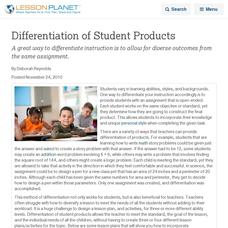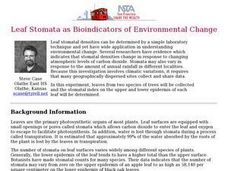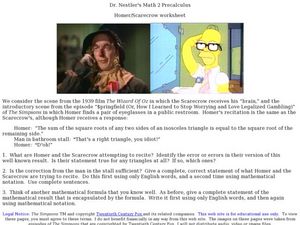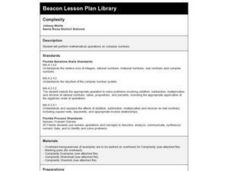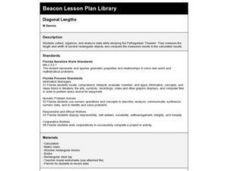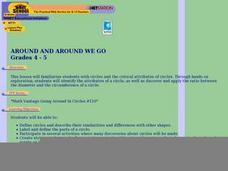Curated OER
What on Earth?
Second graders investigate the different living and nonliving things they can find on Earth. In this life science lesson, 2nd graders record their observations as they dig into the soil. They examine them under the magnifying glass and...
Curated OER
Differentiation of Student Products
A great way to differentiate instruction is to allow for diverse outcomes from the same assignment.
Curated OER
Numbers Beyond Reason!
Fourth graders use the story of the discovery of irrational numbers to explore the different classes of numbers, the different ways in which numbers may be represented, and how to classify different numbers into their particular class.
Curated OER
Leaf Stomata as Bioindicators of Environmental Change
Students, in this experiment, collect leaves from two species of trees and the stomatal index on the upper and lower epidermis of each leaf be determined.
Curated OER
Leaf Stomata as Bioindicators of Environmental Change
Students perform an experiment to determine the stomaltal index on the upper and lower epidermis of two species of leaves. Stomatal densities change in response to changing atmospheric levels of carbon dioxide and to annual rainfall.
Curated OER
Seed Germination
Students explore the process of seed germination. In this botany lesson, students complete an experiment with seeds. Students observe soaked and dry seeds. Students allow the seeds to germinate and make observations during this time....
Curated OER
With Liberty & Top Soil for All
Students compare the basic needs of plants to the basic needs of democracy. In this democracy comparison instructional activity, students complete a worksheet on what happens to a plant that's not nourished. Students draw a correlation...
Curated OER
Mixed Expressions and Complex Fractions
Students are introduced to mixed expressions and complex fractions. They work through several problems with the instructor and then complete a worksheet.
Curated OER
The Orbit Of Planet Gamma
Students investigate the concept of common errors that are made in the laboratory setting while analyzing the data of an experiment. They are given a scenario and are asked to measure the data of the major and minor axis. The purpose is...
Curated OER
Homer/Scarecrow Worksheet
For this Pre-calculus worksheet, students consider a scenes from The Wizard of Oz and The Simpsons refering to the Pythagorean Theorem. Students analyze the statement for errors and write about another mathematical formula that they...
Curated OER
Complexity
Students perform mathematical operations on complex numbers. After a lecture/demo, students utilize a worksheet imbedded in this plan to gain practice performing operations on complex numbers.
Curated OER
Calculating the shortest distance between two points
Eighth graders find the length of the third side of a right triangle.
Curated OER
Problem Solving
Eighth graders complete Calculator Explorations, Problem -solving, and the Discussion topic as outlined in the worksheet from Lola May's Teaching Math - Extending the meaning of multiplication and division.
Curated OER
Pyrotechnics
Students discuss pyrotechnics and what they have noticed about their height and speed. They think about the path which fireworks follow which is a parabola. They follow multiplication patterns to determine the Zero Product Property and...
Curated OER
Escape! Survival of the Fittest Grasshopper
Fourth graders, in groups, design a paperclip grasshopper. They determine its ability to survive a prey by jumping high, far, or with a distracting behavior.
Curated OER
Diagonal Lengths
Students collect, organize, and analyze data while studying the Pythagorean Theorem, measure length and width of several rectangular objects, and compare the measured results to the calculated results.
Curated OER
Around and Around We Go
Fourth graders discover that a polygon is a closed figure formed by line segments, and that the perimeter of a polygon is the sum of the lengths of its sides. They utilize a worksheet imbedded in this plan to gain lots of practice with...
Curated OER
Central Tendencies and Normal Distribution Curve
Fourth graders are given data (class test scores) to determine central tendencies, and find information needed to construct a normal distribution curve. They become proficient in calculating mode, median and average.
Curated OER
Which Is the Better Car Deal?
Learners investigate whether it is more economically sound to take a low financing rate or rebate when purchasing a car.
Curated OER
Flow Rates of Faucets and Rivers
Students work together to discover the flow rates of faucets and rivers. They relate their results to engineering and applied science concepts. They make predictions on the flow rate of a nearby river in their local community.
Curated OER
Base 3
Learners investigate this problem that aims to give a better idea of our decimal system by looking at a comparable system - the base 3 system. By seeing how base 3 numbers work students should have a better appreciation of base 10...
Curated OER
My Son is Naughty
Students find factors of numbers; work systematically; and use logic to explain away certain possible number combinations. They then devise and use problem solving strategies to explore situations mathematically.
Curated OER
Every Breath You Take
Students explore the nature of the air we breathe by observing petri dishes that have accumulated particulate matter from the atmosphere. Students make mathematical calculations and inferences about the effect of this matter on...
Curated OER
Arithmetic Complex Numbers
Students convert quadratic functions from standard form to vertex form. In this algebra lesson, students solve polynomials using synthetic and long division. They derive and apply the remainder theorem and factor theorem.



